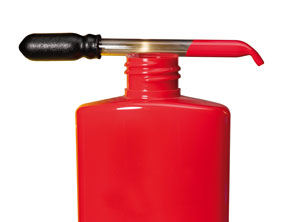CLARIANT
Liquid masterbatch system developed for blow moulding applications / Higher pigment loadings and lower usage
Technology developed by Clariant Masterbatches (Muttenz / Switzerland; www.clariant.com) is claimed to help eliminate many of the problems that in the past have prevented wider use of liquid colour and additive concentrates in extrusion blow moulding of HDPE and LDPE. In initial testing in monolayer containers, “liquid vehicle technology” (LVT) indicates that the systems allow for higher pigment loadings and lower usage rates, while practically eliminating past challenges related to screw slippage, Clariant said. The company added that standard burst and compression-loading tests also show that improved resin compatibility results in stronger weld lines in the finished container.
 The new liquid colour technology enhances flow and allows colour changes in minutes (Photo: Clariant) |
The new masterbatches use a liquid vehicle system that incorporates suspension aids and binders to allow for higher pigment loadings and, in most cases, lower usage rates. Clariant said that additional components in the system enhance flow and allow colour changes in minutes as the LVT products do not adhere to metal surfaces and can act as a cleansing agent, removing deposits left behind by other colorants.
Other claimed benefits include better processing characteristics with reduced screw slippage leading to improved mixing, more complete dispersion and less streaking – it also results in processing temperatures as much as 17°C lower, Clariant said.
Raymond Sloan, head of liquid colour, Clariant Masterbatches North America, said: “Extrusion blow moulders and brand owners in the personal care and household products markets often find liquid masterbatches to be an attractive alternative to solid concentrates. So far, testing has been completed in several types of blow moulded monolayer containers and we are confident that similar results can be achieved in multilayer applications involving both opaque colour and pearlescent effects.”
Other claimed benefits include better processing characteristics with reduced screw slippage leading to improved mixing, more complete dispersion and less streaking – it also results in processing temperatures as much as 17°C lower, Clariant said.
Raymond Sloan, head of liquid colour, Clariant Masterbatches North America, said: “Extrusion blow moulders and brand owners in the personal care and household products markets often find liquid masterbatches to be an attractive alternative to solid concentrates. So far, testing has been completed in several types of blow moulded monolayer containers and we are confident that similar results can be achieved in multilayer applications involving both opaque colour and pearlescent effects.”
21.05.2012 Plasteurope.com [222370-0]
Published on 21.05.2012
